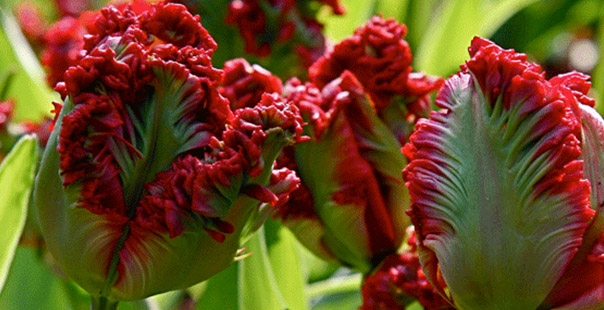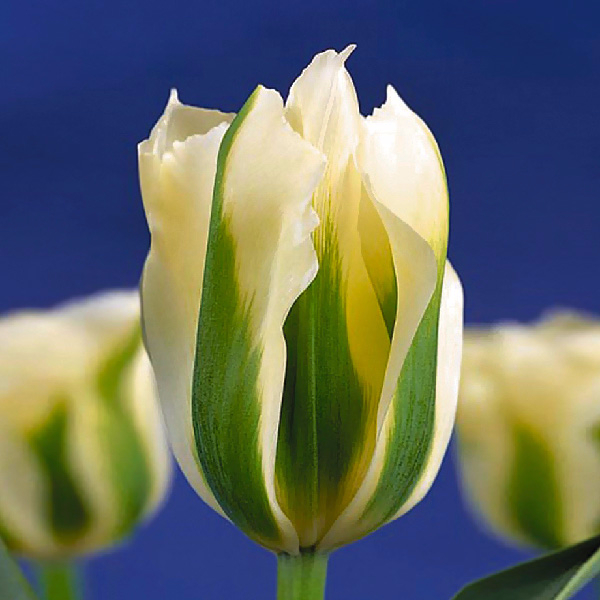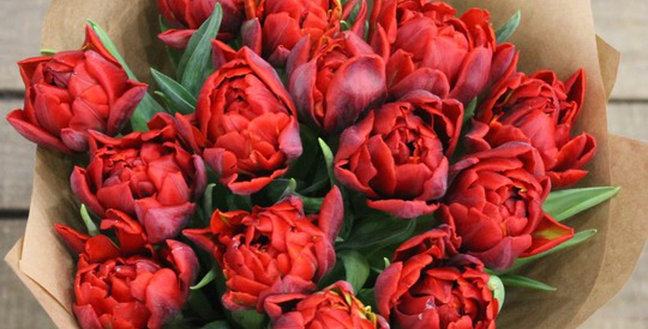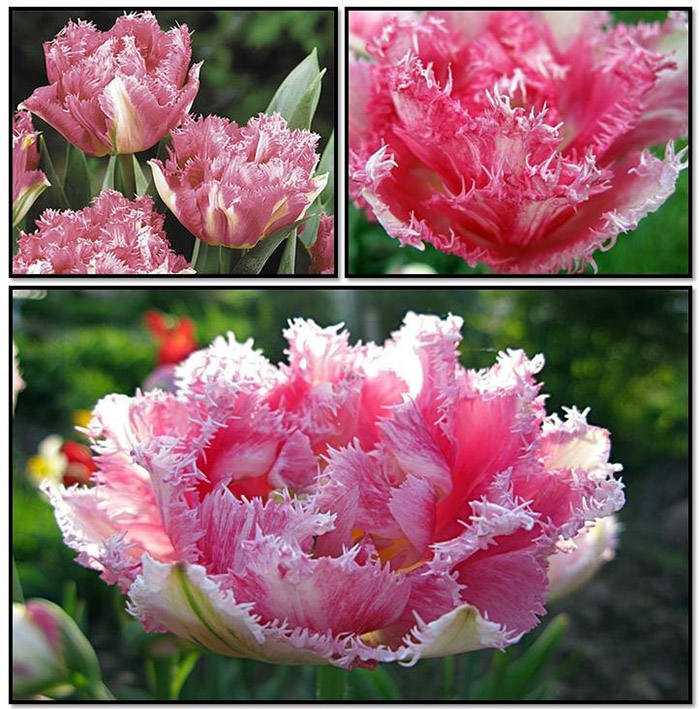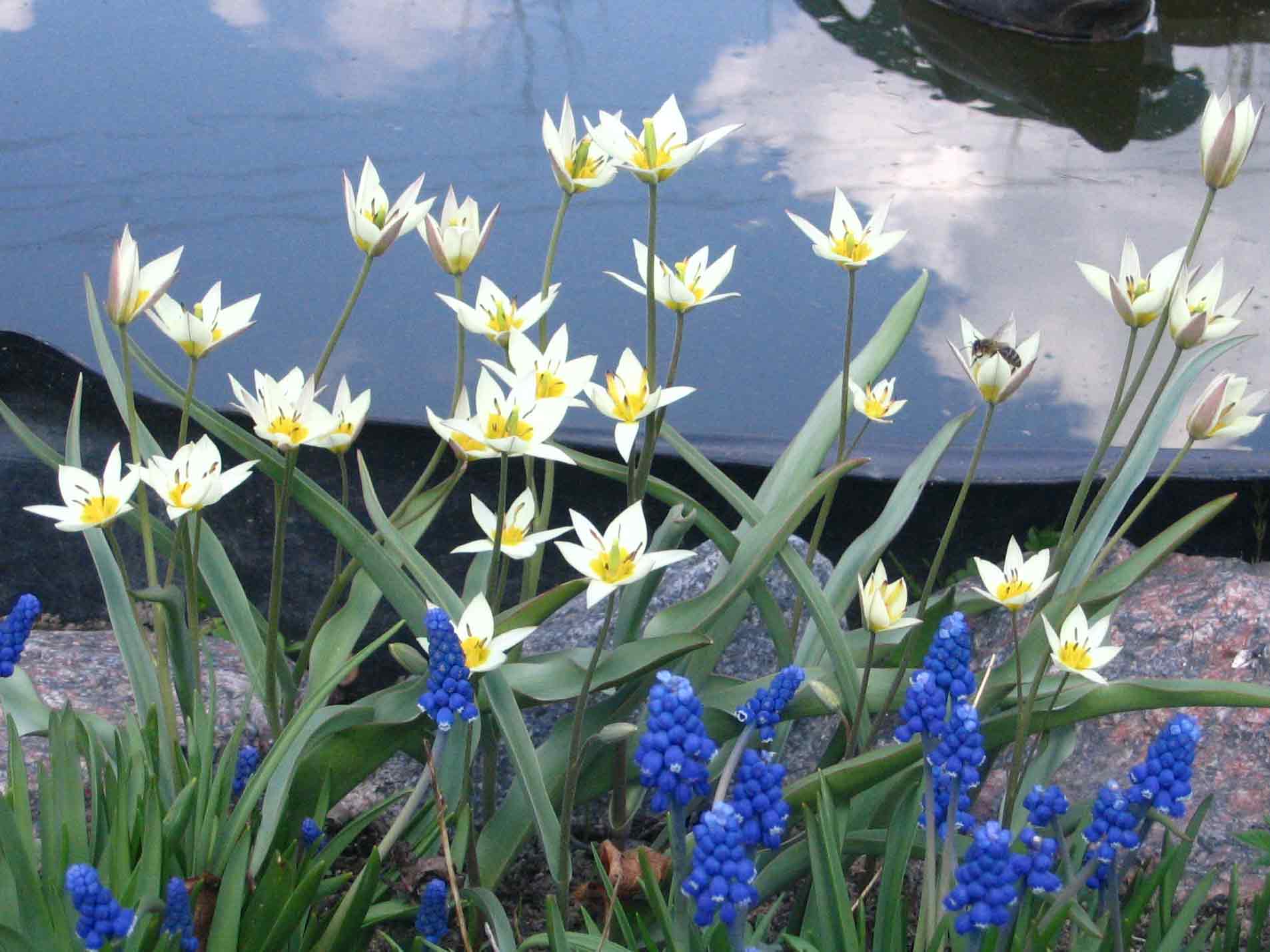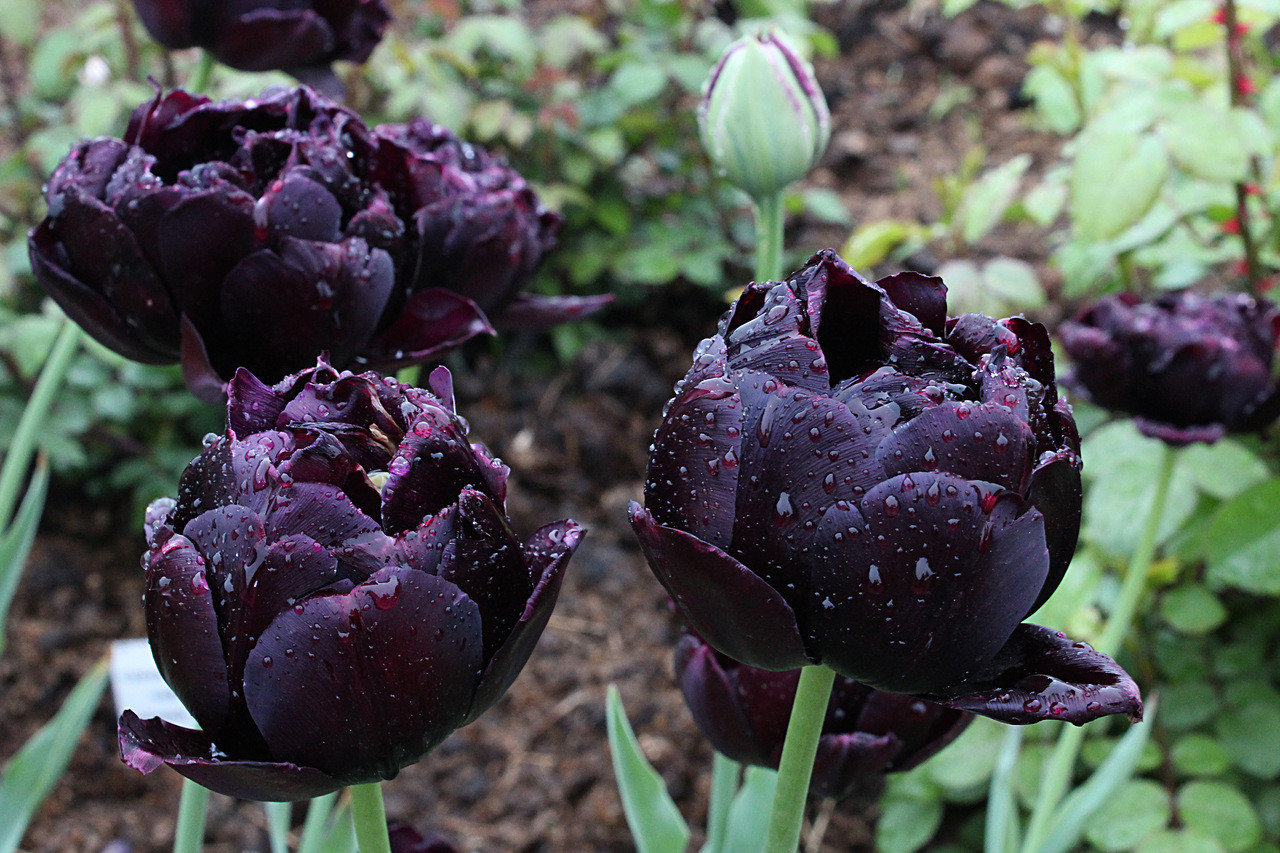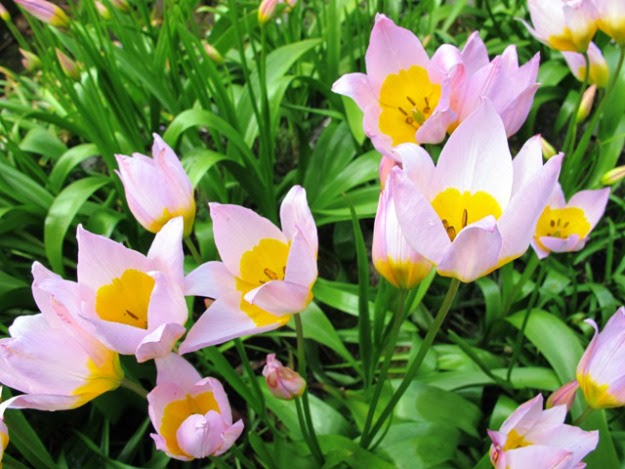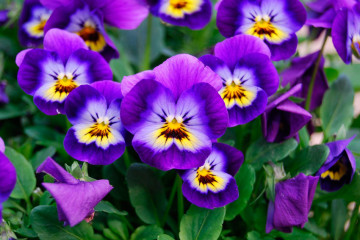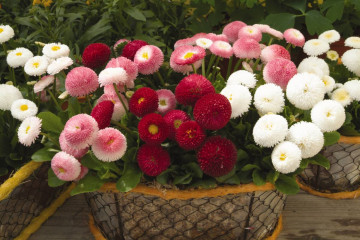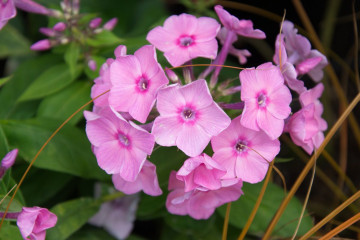Flowers tulips
Content:
The Turks began to cultivate tulips flowers in the distant 16th century. Already in the next century, plants reach Holland and begin their triumphant march across Europe. It is difficult to imagine now suburban areas where this culture would not be bred.
general information
Bulbous perennial tulip of the Liliaceae family is very popular in landscape design, along with daffodils and hyacinths. Plants can also be found in the wild.
If cultivated tulips are only 4 centuries old, then their progenitors are more than ten million years old. The northern regions of Iran are considered the birthplace of the flower. Geophytic plants feel comfortable on the mountain slopes of the Tien Shan and Pamirs.
Thanks to people, there was a widespread settlement with tulips and other latitudes. Plants can be found in the steppes, forest lowlands and even desert areas. The herbaceous perennial adapts well in the dry hot climate of the south, calmly tolerates the cold winters of the northern regions (Siberia, the Urals).
What tulips look like
Forest and steppe tulips are small flowers of a yellowish-whitish or lilac shade. Cultivated can be as high as 10 cm and reach 1 meter. The tulip flower takes on a different shape depending on the species:
- goblet;
- star-shaped;
- lily-shaped;
- terry;
- oval;
- corrugated parrot;
- cupped.
In addition to the shape, the coloring of the buds is varied. Traditional tulips are pink, but you can find white, yellow, lilac and even purple-black.
The plant is characterized by a special shape of the modified stem. All organs are formed in a filmy bulb. Leaves and peduncles depart from it. Corolla and perianth consist of lobes, the number of which is a multiple of 6. The same number of stamens on the flower. The pistil has a 3-lobed stigma.
When tulips bloom
Tulips and daffodils often coexist in flower beds next to each other and are the flowers of the spring season. By the time of flowering, plants are classified into groups:
- early flowering ones begin to smell sweet in March and are pleasing to the eye until the beginning of May; subdivided into 2 classes: simple tulips and double tulips;
- mid-flowering covers the end of April and May; these include the Mendelev class and the Triumph, as well as Darwin's hybrids;
- late blooming can be admired in the second half of May; this group is more ramified into classes: non-double (Darwin, Brieder, multiflorous), Liliaceous, Fringed, Green-flowered, Rembrandt, Parrot, Terry.
Professionals distinguish another group of tulips, which is as close as possible in characteristics to wild plants. They are divided into hybrid classes and those types that are most similar to the original form. Their main budding period is April-May.
Knowing when tulips are blooming, you can plant varieties from different groups on the flowerbed at the same time. This will allow you to enjoy the colorful beauty from early spring to early summer.
Varieties and types of tulips
Tulips are such a diverse crop that experts do not have a consensus on how to properly classify these plants.In addition to dividing by flowering time, tulip varieties are combined into groups according to common characteristics. One of them is the structure of the flower.
Peony tulips
The buds of this species, indeed, resemble peonies from afar. The varieties are distinguished not only by the shape of the flower, but also by the original color:
- Royal Acres has bright purple double inflorescences;
- Monte Carlo has a yellow flower;
- “Humilis Tet-a-tet” has red petals pointed at the top;
- the yellow-orange "Sensual Touch" is characterized by a fringed border;
- white petals of the terry inflorescence "Cartush" are beautifully edged with bright pink stripes;
- the pink and white "Angelica" has green stripes on the outer petals below;
- deep orange "Sun Love" boasts delicate red veins.
It is easy to confuse purple peony tulips "Blue Diamond" and "Dream Toch" with bush flowers of the same name family.
Terry tulips
In fact, these are the same peony flowers, differ from simple tulips in the arrangement of petals in several rows. Terry tulips are classified into early and late groups.
Tulip varieties with multi-tiered inflorescences
| Variety | Features of the | Flowering period |
| Early | ||
| "Mr. Van der Hoof" | Reaches a height of 0.2-0.4 m.Gives golden-yellow flowers 10-12 cm in diameter | End of April - beginning of May |
| "Murillo" | The peduncle barely reaches a length of 40 cm.At the beginning, the inflorescences are white, by the end of flowering they acquire a pinkish tint | |
| "Electra" | A low stem (from 20 to 40 cm) is crowned with a cherry-red bud, the average diameter of which is 10 cm | |
| Late | ||
| "Uncle Tom" | On a stem of 0.3-0.4 m, a dark cherry inflorescence with a creamy center is formed | End of May - beginning of June |
| Don Pedro | A half-meter plant gives an inflorescence of a spherical shape of orange-purple color with a brown center | |
| "Dilinburg" | A fairly tall flower - up to 70 cm in height. Highlighted by its mixed color in orange and raspberry tones | The end of May |
| Mount Tecoma | The average plant height is 0.4-0.5 m.Attention is attracted by snow-white double buds | First half of May |
| "Symphony" | Reaches a height of just over half a meter. Gives medium-sized (up to 9 cm in diameter) bright crimson inflorescences | Mid may |
Dense double varieties "Gold Medal" with golden-yellow inflorescences and carmine-red "Koksa" will become a real decoration of landscape design.
Botanical tulips
This is a special group of tulips of natural origin. The species are inherent in the habits of wild plants. Plants are unpretentious in growing, therefore they are often used to decorate rocky gardens and alpine slides.
Morphological features
To understand what such tulips look like, it is enough to remember those plants that are found in the wild. They can rightfully be called dwarfs - most varieties barely reach a height of 20 cm.
Despite the "ignoble" origin of the varieties, summer residents love to grow botanical tulips. First of all, it attracts a variety of colors, as well as the curliness of the leaves of some species.
Botanical varieties
In the wild nature of Russia there are tulips of Turkestan, Lipsky, Batalina, forest, two-color, pointed. In summer cottages, they prefer to grow hybrids with features of wild plants.
Types of botanical tulips
| Name | Description |
| Alberta | The dwarf has a pubescent stem and a curly leaf. The flowers are single, orange-red with a black bottom |
| Greig | You can find out by the speckled foliage. The flowers are large, with a wide base and a slight bend. They have different colors ("Tango" are orange-scarlet, "Pandur" is a two-color combination of light yellow with carmine red) |
| Kaufman | Quite squat plants.The gray-green foliage is decorated with specks. At the perianth, the leaves are yellow or white inside, sometimes with a red border. Star-shaped flowers differ in color. What it will be depends on the variety ("Brilland" dark pink, "Robert Schuman" yellow, "Eliot" white) |
| Foster | Among other dwarfs it is considered a "giant" - it grows up to half a meter. The tulip has a powerful pubescent stem, with a darker top. It stands out with wide leaves, elongated buds and bell-shaped perianths. Flowers can be painted in fiery red ("Cantata") or orange ("Juan") tones. In this case, the bottom of the bud is either yellow or dark purple |
| Eichler | In the “baby”, the pubescent stem is hidden behind narrow, slightly bent leaves. The plates are framed with a wavy red border. Single bell-shaped flowers have a wide base with a shallow interception in the middle. The buds have a dark bottom and a yellow border on top |
You can also find the Excellent tulip. In the species, not only the stem is strongly pubescent, but also the leaves. On the bush, from 1 to 3 (sometimes 5) flowers of a uniform shade from orange-golden to dark crimson are formed.
Growing technology
The step-by-step algorithm applied to tulips with biological features does not differ from what is practiced for ornamental varieties. The workflow includes the following nuances:
- after the plant has faded and the stem dries up, the tulip bulbs need to be dug up and dried on paper laid on the table;
- before planting, the onions, peeled from the scales, are stored in a dark, cool place;
- it is necessary to plant in open ground in the fall (closer to the cold weather), choosing a well-lit area with loose soil;
- so that the plants do not interfere with each other's development, they adhere to the planting plan:
- the distance between the holes is made 7-10 cm (you can measure it with the palm of your hand);
- the mother's bulb is buried 15 cm;
- large baby - 10 cm;
- small - 4-5 cm;
- if the soil is sandy, add another 2 cm depth to the specified parameters;
- on depleted soils, it is recommended to feed the plant immediately (but you cannot use manure).
So don't wonder when to dig up daffodils and tulips. If the former can still sit for several years in the ground without sacrificing decorativeness, then the bulbs of the latter are best removed from the ground every summer (in June).
Diseases and pests
Botanical varieties are considered hardy plants with high immunity against infections. But sometimes you can see specks and stripes on the leaves, which indicates such a problem as variegation. The disease can be provoked by its carrier - aphids.
There are other problems that the flowers of this group are exposed to:
- if the leaves turn yellow and dry, you can blame a bear, a click beetle or an onion mite;
- if the entire ground part began to wither sharply and became covered with a grayish bloom, this is evidence of a defeat by Fusarium;
- the nematode eats the root part, provoking bacterial rot.
If pests can still be dealt with with special preparations, then it is better to remove plants affected by fungi from the flower bed together with an earthen lump. Slightly damaged leaves can be trimmed and flowers treated with fungicides.
Dutch tulips
The main work on the selection of this plant is carried out in the Netherlands (it is not for nothing that flowers are considered a symbol of this country). In fact, all tulips can be called Dutch. Thanks to the Dutch Botanical Gardens, they became known all over the world. From here, the first varieties began to spread across the continents.
Several centuries ago, the Scandinavian country was "sick" with tulip mania, and the prices for the plant's bulbs were high.But as soon as the breeders "put on stream" the cultivation of magnificent flowers, the excitement subsided, and the tulips left Holland, going on a journey around the world.
New original varieties are still presented to flower growers by the master breeders of the Netherlands. Thanks to their efforts, the buds come in unusual color shades.
Blue
Blue tulips can only be called conditionally, because there is no delphinidin pigment in the chromosome set of the plant. Some varieties with lilac or violet buds under a certain beam of light cast blue or blue (for example, "Blue Spectacle" or "Blue Ribbon", "Blue Parrot").
Purple
This color variety can be found in many garden beds. Purple tulips have a different tonality: from pale light to deep dark (almost black) shade. The most popular among them are "Queen of the Night", "Pearl Crystal", "Walflower", "Black Hiro".
Multi-flowered tulips
Usually, the bulb throws out one tulip at a time. But there is a variety of bush-type flowers. Such plants look unusual - there is a feeling as if a whole bouquet was stuck into the ground.
Multiflorous tulips are not distinguished by specialists in a separate group. The first varieties belonged to the group of late flowering plants with simple flowers. Now there are fringed and terry hybrids with an average flowering period. The most famous among them are the varieties with the Triumph stamp.
The disadvantage of bush tulips is their rapid degeneration. If in the first year the bulb gives a lush bouquet, then after a couple of years even single buds may not bloom even with good care.
Jerusalem tulip
Among the types of tulips, the name "Jerusalem" does not officially exist. Perhaps amateur flower growers call plants that are ubiquitous in Israel. Short, beautiful tulips have large, simple red buds. You can also find purple dwarfs and multi-flowered plants.
Liliaceae have become the most common crops for summer residents. Now the question does not arise how much tulips cost. Even the newer bulbs are affordable. You can get hold of classic flowers for free from your neighbor. Therefore, tulips are grown everywhere for garden decoration or for cutting into bouquets.

